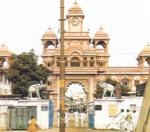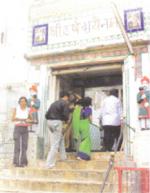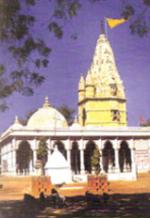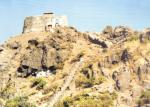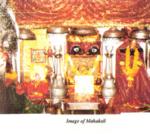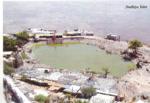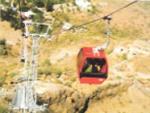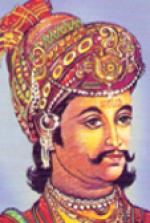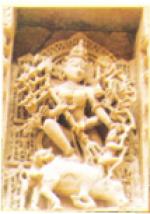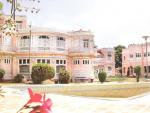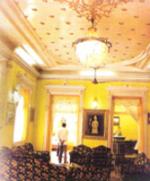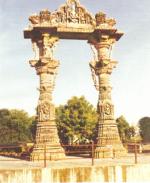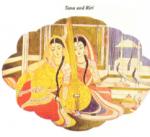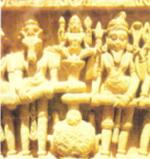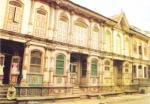We come to Gondal on the way to Virpur. Gondal is famous for the Swaminarayan temple. In the city are also one Bhuvaneshwari Shaktipith, a Library and Ayurvedic pharmacy and college that it runs under its management. The most notable personality of Gondal is Darbar Bhagvatsinhji, an incarnation of simplicity and service besides a great patron of scholars. Although a king of a rich state, he lived very simply. He was highly interested in the development of Gujarati language and he has left a great legacy in 'Bhagvad Gomandal', a great and absolutely authentic Thesaurus - Dictionary of Gujarati language that has been a boon for all scholars of generations to come. It contains as many as 300000 words of this language .
Sunday, October 30, 2011
Porbandar
As we cross the creek here we come to the Miyani village. The innumerable commemorative stones of the persons who laid their lives for some legendary reasons over the time, appear from a distance as if a large group of cows are sitting down to ruminate. After saluting the bravery shown in wars, romantic stories and self sacrifice, we move on further to reach the town of Porbandar.
Another name of Porbandar is Sudamapuri, a city named after the best, if the poorest friend of Lord Krishna. Another such famous man of Porbbandar, also keeping himself like the poorest of Indians, wearing only one unstitched cloth and yet an incomparable man is viz. Mahatma Gandhi. While the life of the first Sudama lives on only in traditional literature, the story of Gandhi is very recent and most well known over the world.
It is said that since the time of Raja Vikramsinh, the post of chief minister of the state was in the hands of the Gandhi family. The last of the scions was Karamchand Gandhi. To his wife Putliba was born Mohandas, who later became India's 'Father of the Nation'. It is a coincidence that Gandhiji's wife Kasturba also was born in the same city and she also came to be called 'Ba' or Mother by everyone in India. Even today we can see the room and the home where Gandhiji was born. It has naturally become a place of national heritage, and is renamed as "Kirti Mandir'. It gives a real thrill to actually be there and not just see but touch the things that Gandhiji must have touched and used in his early life there. This "Kirti Mandir' has been erected by another great son of the town, Nanji Kalidas. He has aiso built 'Bharat Mandir'and 'Tara Mandir' in the memory of the great ancient sages and seers of India and some images of these distinguished men and women are also placed here.
Porbandar has not only Gandhi Smritit and Gurukul as places of interest; it also has the ancient temple of Sudama. The greatest attraction however is its seacoast, and one should never leave the town without looking at it.
It is said that Porbandar is the city, well-known for two Mohans. One is the Lord Krishna one of the names for whom is Mohan and another is Gandhiji-whos real name is 'Mohan' das Gandhi.
Saturday, October 29, 2011
Pavagadh Of Mahakali
The history of Pavagadh is connected with Patai Raval. The base of the mount is called Champaner, a city that Vanraj Chavda founded to commemorate his Chief Minister, Chaampa. The Patai family of the Raval branch ruled here and guarded the borders. Legend says that once Goddess Mahakali, whose temple was on the peak, came down to Champaner to play the 'garba', a folk dance, in the form of a lady. The last ruler of this line, Jaisinh eyed her with lust, and so the Goddess cursed him. As a result, within a short period the Gujarat ruler, Muhammad Begda invaded and conquered Pavagadh. The Patai ruler lost the battle and was killed. Begda shifted his capital from Ahmedabad to Champaner.
Pavagadh is considered very sacred and it is believed to fulfill all the wishes of the devotees. For this purpose the Japa, Mantra and Tantra, Anushthan and other religious rites are to be performed in the worship of the Goddess A number of saints and ascetics are advancing in spiritual pursuit while living at various peaks of this mountain and offering worship. This place of worship of the Mother Goddess Mata Kalika Bhavani, as she is also known, is famous for fulfilling the wishes and needs of Her devotees. The Shri Kali Mantra is considered the best for the Japa or chanting in order to please Her and get the wishes fulfilled. Tens of thousands of people visit this sacred site to pay their respects to the Mother Goddess here.
As it is a 'Shakti-pith', the temple does not have an image of the Goddess, but merely a niche or recessed place called 'gokh'. Here the 'Kalika Yantra', placed at the center of Gokh is offered worship. To its right is the image of Kalika Devi, to the left is the 'af!gi' of Bahucharaji Mata and a little away on the left is the image of Mahalakshmi Mata. Pavagdh also has great attraction for the followers of Jainism, for this extremely beautiful place is also for them a highly sacred place called 'Siddha Kshetra'. All those places where the Jain Tirthankaras, Muni Maharaj, great Acharyas, Upadhyayas or Gandhars breathed their last, attained Nirvana or Moni Gati, turned into important places of worship for the devotees. There are 9 sacred temples of Digambar sect of Jains at Pavagadh, and 7 of them are on the highest Maulia Peak, situated between Dudhiya lake and Chhasia lake on a small and narrow flat peak of Takorkhana Nagarkhana. Three of them are on the banks of Dudhiya Lake. The ancient and huge Jain temple is of the 7th Tirthankar Prabhu 1008 Shri Suparshvanath Bhagvan of Digambar sect. The image of this Digambar Tirthankar is seated facing the E~st and his image is most beautiful. Thousand years old, this temple has the structure with 52 Jinalayas and has been renovated time·and again and is standing proud at the bank of Dudhiya Lake today.
Another Jain temple is called 'Daheri' houses the 'charanpadukas' of the sons of Lord Rama, namely Lav and Kush who are said to have accepted Jainism and assumed the names of Ananglavana and Madankush, and they are said to have attained Moksha here.
Patan - The Ancient Capital of Gujarat
Patan became the first capital of this region after it came to be known as 'Gujarat.' After its foundation being laid in about 14th century, for nearly 650 years Patan retained its capital status almost constantly. Besides, it also became the center of culture. We find that there are a large number of Maths and Pathshalas on the border of Sahasralinga Lake. During the rule of Bhimdev I, Karnadev, Siddharaj and Kumarpal, it was at the apex of its glory. At that time Patan measured upto 30 km in its size, had 84 'chauta' and 84 'chowk'.It had a very large population as well.
The legend has it that Vanraj Chavda who was the founder of Gujarat's empire, had a shepherd friend from his younger days, and after him he named the capital as Anahilpur Patan. According to the traditional story, Vanraj Chavda laid the foundation of this cit~ at the place pointed out by Anahil, the shepherd, in V.S. 802 (AD 746, March 28 ). The young Vanraj had been in the care of his mother Rupsundari and maternal uncle Surpal after his father Raja laishikhari was killed in battle against Raja Bhuvad of Kalyan. Vanaraj surrounded himself by young braves and then laid the foundation of his capital Patan. From the rule of Vanraj Chavda the history of Rajput rule in Gujarat takes off. Even today we can see the image of Parasnath that was brought from Panchasar and installed in the Panchasara Parasnath Derasar (Jain temple) at Patan in his time. In one of its niches we see an old image of Vanraj himself. The golden age of Gujarat was achieved under the rule of Sidhhraj laisinh. We find great descriptions of this large metropolitan city of Patan in many books of the time that sing the praises of its beauty and prosperity as the capital of a wealthy empIre.
Patan during the Solanki period was full of numerous large mansions, temples and other architectural beauties. Today we can see some of their ruins. Recently the excavations have revealed the 'Rani ki Vav' that is a most amazing and beautiful structure, fullofwonderful architecture and sculpture. Builtby the Queen Udaymati, the wife of Bhimdev, it is the best example of such architecture for water wells that is peculiar to Gujarat. There are wonderful carved images in the niches of the walls of this multi-storied step-well. Besides this, we find many beautiful lain temples in Patan. Also, there are a large members of ancient manuscripts in these temples & private libraries also have many manuscript copies preseaved overtime. By the efforts of Mr. K. M. Munshi, a Hemchadra Memorial Center has come up here to look after this unusual and one of the most valuable treasures of India.
Patan has been made into a new District, with the city as its Headquarters. The world famous industry of weaving of 'patola' saris that flourished at one time here is about to be extinct, for only one family is keeping this art as a profession today. The other Sanskrit scholars that may have written many learned works when they taught and studied in the Sanskrit Pathshala next to Sahasralinga Lake, for we cannot find the works nor have we any memories of the scholars. The lain ascetics, besides the famous Hemchandra, such as Ranchandra, Gunachandra and many others knew the religious tenets deeply, and were commanding literary personalities as well. Their memories have been preserved in the works found in the libraries maintained at Patan. After Allauddin Khilji ransacked Patan, Ahmed Shah changed the capital and founded the new capital of Ahmedabad on the banks of River Sabarmati. This heralded the end of the importance and great glory that was Pata
Friday, October 28, 2011
Rajpipla - Rajvant Palace
In 1915, Maharaja Vijaysinhji constructed this Rajvant Palace on the bank of River Karjan, which gives an aura of some grand building of England. It looks like an European mansion with a Roman dome, Greek net-work, Venetian doors and an attractive arch above them. The architecture on the whole delights the eyes. The huge oil paintings of royal scions, the bright lights of the huge chandeliers and the overall royal effect really invoke awe and wonder
This palace has many large rooms. Some of these are reserved to present as memoirs of the past rulers that include trophies indicating their bravery, stuffed heads Gf wild animals they killed during hunting games, and sa an. In same rooms the furniture is C\ITangedtastefully as lounges for the visitors. The facilities are of really modern standards. A beautifully decorated restaurant in the palace severs all kinds of cuisines. The Palace also has a Conference Room, Banquet Hall and its facilities for bigger occasions.
A beautiful museum displays the lifestyle of the tribes and villages. A cultural center is active in this too. During your stay at the Rajvant Palace of Rajpipla you can easily visit the sacred places like Chanod and Karnali on the River Narmada. The other places of interest within reach are Nareshvar, Garudeshvar and Dabhoi
Vadnagar - The Home of the Nagar Community
Just as Visnagar is the original home of the Visnagar Nagar community, Vadnagar is the original home of the Vadnagar Nagar community. Vadnagar has a large Shiva temple, Hatkeshvar Mandir, whom this Nagar community offer worship as their Ishtadev. From here the members of this learned and cultured community have spread to different places. The area of Visnagar- Vadnagar is very ancient. Vadnagar has been known in the past as Anartpur, Anandnagas, and Chamatkarpur also. At that time it was a capital city of the region. It boasted of not just prosperity, but scholarly activity and fine arts, specially dancing and music. According to local tradition, there were two Nagar girls, named Tana and Riri who lived here.
Tansen, one of the Navratna and court-singer of the great Mughal Emperor Akbar happenned to sing a Raga called 'Deepak'. This Raga left him in agonies, for it created an internal fire in his body. He did not know how to diffuse this fire, except by singing the Raga Megha Malhar. Unfortunately he had no knowledge of this Raga. He went about everywhere looking for someone who would sing it to him and end his pain, but to no avail. When taking his trip he came to Vadnagar, the two Nagar girls, Tana and Riri sang the Megha Malhar Raga for him and ended his agony. We find the 'samadhi' of the two girls even today in Vadnagar. Every year now the Gujarat Govt. invites famous musicians in a program me to encourage them and thus the two girls are offered the commemoration through music. The Chinese Traveler, Hiuen Tsang visited Vadnagar and has mentioned so in his travel notes. The inscription at the Arjun Bari Gate provides a very good description of the grandeur of Vadnagar.
HATKESHVAR Mahadev temple:
This Shiva temple is considerably ancient. As this is a town on the borders of Gujarat, it must have suffered from time to time from attacks, and so the temple also has been renovated time and again. The archaeologists consider the present structure as nearly 400 years old. It is temple built after the Solanki era. It is one of the most important and grand temples of Lord Shiva in Gujarat. In the 'Vedi' surrounding it are found the sculptures of the Ten Avataras of Lord Vishnu and other figures from the stories of the Puranas. It has a tall Shikhara that looks down into the 'garbhagriha' and its beautiful and artistic arches are very attractive. In the center of Vadnagar is Sharmishtha Lake with banks, and stone railings. A little away from here we find two 'Torans' called 'Shamalsha ni Chowri'. They are among the few better preserved 'torans' of Solanki era. We had referred to such 'Torans' when we talked of Kapadvanj. Then we have a 'Toran' at Piludra in Mehsana district. The 'Kirti Stambha' at Vadnagar is 14 m tall. The fort built by Kumar Pal around the city with its four Gates in four corners, and the few remnants of these structures are with us to remind us of its former glory. On the route from Mehsana to Taranga Hill, Vadnagar is at about 40 km distance. The Arjunbari Gate is the entrance to the city and is also known as 'Nak Darwaza'. Just nearby is the prestigious temple of Hatkesvar Mahadev, to whom the Nagars offer worship as their Ishtadev or Kuldev.
It is said that when Lord Vishnu took the fonn of Vamana and later assumed the Virata form at the Sacrifice or Yagna, He put his foot first at Vadnagar. This city was earlier called 'Chamatkarpur' or a City of Miracles. Lord Shrikirshna and the Pandavas had also visited this city. The wedding of Shamalsha, the son of saint-poet Narsinh Mehta, took place here. It is believed that the God himself led his wedding procession and thus came to this place.
Certain historians believe that the Nagar community came to India from the northern side of Kashmir. Whatever the tradition says, it must be admitted that this community looked after its purity of blood as migrants. Members of this community are famous for their bravery, scholarship, arts and learning besides statesmanship. Not only have the Nagar Brahmans patronized arts and learning, they are personally experts what they call in using 'kalam' (pen), 'kadchhi' (ladle) and 'barchhi' (sword)'. The Nagars have a very fine division among them: those who merely give patronage are called 'Nagars', while the rest are "Nagar Brahmans'.
Thursday, October 27, 2011
The Haveli At Siddhapur
The Bohras are found in large numbers in Siddhapur. Although the Bohra community follows Islam, they differ to some extent from the rest of the Muslims. During the Solanki rule, the Shia preachers were able to convert Brahmins and Banias into Islam and these are known as the Bohras. This conversion occurred after the invasion of Allauddin Khilji. The houses of the Bohras at Siddhpur are of semi-European fashion, with terraces with railings. The windows are of colored glass and the furniture is similar to rich Muslim households. In the rich homes we find even today many chandeliers with light holders (handi). There were king-sized beds with canopies, tables with marble tops, carved cupboards, glass utensils with lovely carvings or paintings on the walls. Form the outside these 'Haveli' type houses are quite simple in appearance, but within its large rooms it has beautiful furniture and decorations.
Miradatar:
Apart from the lain places of pilgrimage, to the n0l1h of Mehsana near Unjha and Unava is the sacred place for the Muslims called Muiradatar. However, here not just the Muslims but the Hindus also come for worship and offerings. All communities join its Fairs held regularly.


